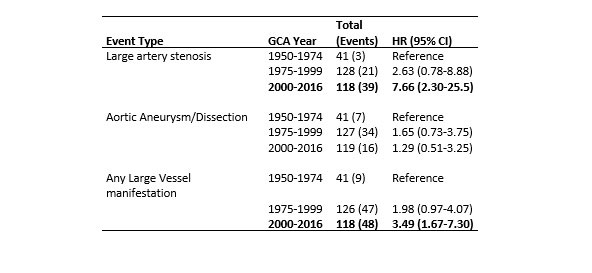Session Information
Date: Saturday, November 12, 2022
Title: Vasculitis – Non-ANCA-Associated and Related Disorders Poster I: Giant Cell Arteritis
Session Type: Poster Session A
Session Time: 1:00PM-3:00PM
Background/Purpose: Screening for large artery manifestations has been adopted by clinicians managing patients with Giant Cell Arteritis (GCA). The contemporary effect of the increased use of imaging studies on the incidence and outcomes of large artery manifestations remains unclear. In this study, we aimed to investigate incidence trends and outcomes of large artery manifestations in a population-based cohort of patients with GCA over 70 years.
Methods: The study cohort included patients with incident GCA between 1950-2016 in a defined geographical area. Incident large artery manifestations were defined as aortic aneurysm, aortic dissection, stenosis in the aorta, or any of its main branches diagnosed within 1 year prior to the diagnosis of GCA or anytime afterward. Patients were followed till December 31st, 2020, death, or migration. Cumulative incidence of large artery manifestations adjusted for the competing risk of death was estimated. Cox proportional hazards models adjusted for age and sex were used to assess the association of clinical characteristics with large artery manifestations.
Results: The cohort included 289 patients with GCA :222 (77%) females; mean age at diagnosis was 76.4 ± 8.2 years; temporal artery biopsy was positive in 235 patients (81%) and mean ESR was 75.1 (±30.4) mm/hour. Mean follow up period was 10.4 ± 7 years. Incident large artery manifestations developed in 104 patients throughout the follow up period, most were found incidentally on imaging (76%).
Cumulative incidence rates of large artery manifestations at 5 years were 7.3% (95% CI 2.4-22.1%), 15.9% (95% CI 10.6-23.8%) and 27.2% (95% CI 20.2-36.6) for patients diagnosed in 1950-1974, 1975-1999 and 2000-2016, respectively. Moreover, cumulative incidence of large vessel manifestations at 15 years was 14.8% (95% CI 7.0-31.6%), 30.2% (95% CI 23.1-39.4%) and 48.8% (95% CI 38.8-61.3%) for patients diagnosed in 1950-1974, 1975-1999 and 2000-2016, respectively (Figure 1).
Patients with GCA diagnosed in 2000-2016 and 1975-1999 had more than 3.5-fold and 2-fold increase in incidence of large artery manifestations (HR:3.49 95%CI 1.67-7.3 and HR: 1.98 95% CI 0.97–4.07, respectively) compared to 1950-1974. However, there was no significant increase in aortic aneurysm or dissection (Table 1).
Clinical predictors for large artery manifestations included weight loss, fatigue, arm claudication, ever smoker and bruit on physical examination. On the other hand, cranial symptoms were negatively associated with large artery manifestations (Table 2)
Mortality risk has significantly decreased in patients with large artery manifestations diagnosed in 2000-2016 (HR 0.38 95% CI 0.17–0.81) following no significant improvements in 1975-1999 (HR 0.61 95% CI 0.29-1.30) compared to 1950-1974 (reference).
Conclusion: Incidence of large artery manifestations (mainly large artery stenosis) has increased over time likely from increased awareness and greater use of imaging studies. The incidence of aortic aneurysm/dissection has not changed over the last 7 decades. Mortality improvements may be due to earlier detection and identification of large artery manifestations.
To cite this abstract in AMA style:
Elfishawi M, Kaymakci M, Achenbach S, Crowson C, Kermani T, Weyand C, Koster M, Warrington K. Increasing Incidence of Large Artery Manifestations in Patients with Giant Cell Arteritis, a Population-based Cohort over 70 Years [abstract]. Arthritis Rheumatol. 2022; 74 (suppl 9). https://acrabstracts.org/abstract/increasing-incidence-of-large-artery-manifestations-in-patients-with-giant-cell-arteritis-a-population-based-cohort-over-70-years/. Accessed .« Back to ACR Convergence 2022
ACR Meeting Abstracts - https://acrabstracts.org/abstract/increasing-incidence-of-large-artery-manifestations-in-patients-with-giant-cell-arteritis-a-population-based-cohort-over-70-years/



